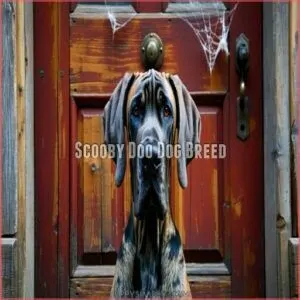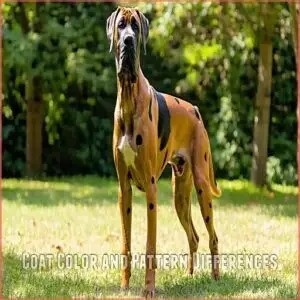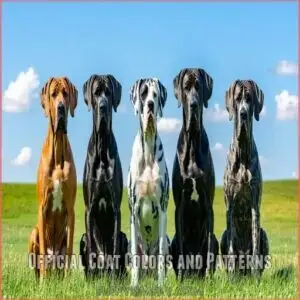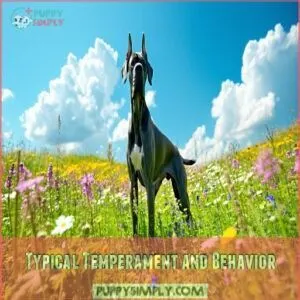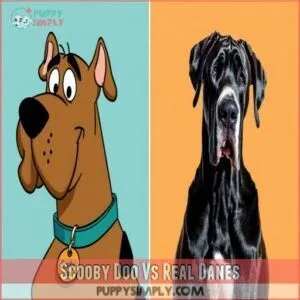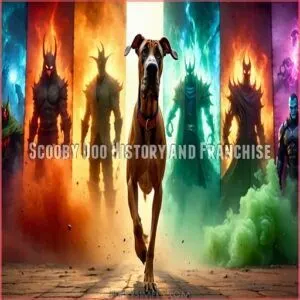This site is supported by our readers. We may earn a commission, at no cost to you, if you purchase through links.
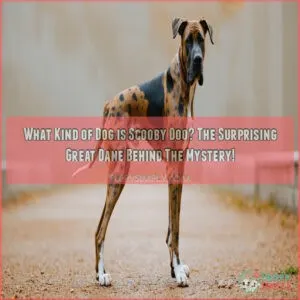
Yep, that lanky, goofy dude is supposed to be one of those majestic pups. Funny, right?
He’s got those bowed legs, a wonky smile, and a coat like a chocolate chip cookie, not exactly your typical prize-winning Dane.
He’s more likely to trip over his own feet than win a dog show. But that’s what we love about him!
He’s a scaredy-cat, sure, but he’s also loyal and always ready for a Scooby Snack.
Want to know more about the differences between Scooby and real Great Danes? There’s a whole lot more to this story!
Table Of Contents
- Key Takeaways
- Scooby Doo Dog Breed
- What Kind of Dog is Scooby
- Scooby Doo Physical Traits
- Great Dane Characteristics
- Scooby Doo Vs Real Danes
- Scooby Doo Intelligence and Skills
- Scooby Doo History and Franchise
- Finding a Scooby Doo Dog
- Scooby Doo Cultural Impact
- Frequently Asked Questions (FAQs)
- What kind of dog is Scooby-Doo in real life?
- What breed of dog is Goofy?
- What kind of dog was Scrappy-Doo?
- What breed of dog is Odie?
- What breed is Scrappy-Doo?
- What kind of dog is Clifford the Red dog?
- What breed of dog is Shaggy?
- What are Scooby Snacks made of?
- How much does Scooby-Doo weigh?
- Why does Scooby-Doo talk – isn’t he a dog?
- Conclusion
Key Takeaways
- You’ll discover Scooby-Doo is a Great Dane, though a stylized version, unlike typical show dogs. His design intentionally deviates from breed standards with bowed legs, a sloping back, and an unusual coat.
- You’ll learn Scooby’s personality contrasts with real Great Danes. While the breed is known for being gentle giants, Scooby is famously cowardly, though still loyal and affectionate.
- You’ll find Scooby’s intelligence shines through his problem-solving skills, despite his goofy nature. He’s a cunning escape artist and surprisingly adept at cracking puzzles.
- You’ll see Scooby’s cultural impact stems from his lovable personality and enduring popularity. He’s become a cultural icon, entertaining audiences for generations.
Scooby Doo Dog Breed
You’ll be surprised to learn that your favorite cartoon canine detective, Scooby-Doo,
Origin and Creation
Everyone’s favorite mystery-solving canine has quite the tale behind his creation.
The Character Design journey of Scooby-Doo took some fascinating turns before settling on the Great Dane breed we’re familiar with today.
The developers’ choice of breed was influenced by common dog breed stereotypes.
Here’s how your favorite cartoon dog came to be:
- Started as "Too Much," a bongo-playing sheepdog
- Ken Spears and Joe Ruby crafted him for Hanna-Barbera in 1969
- Developers chose a Great Dane to challenge breed stereotypes
- They intentionally designed him opposite to prize-winning standards
- Named him Scoobert "Scooby" Doo as the final touch
Designer and First Appearance
Iwao Takamoto brought Scooby-Doo to life at Hanna Barbera, crafting a character design that’d make you chuckle.
He purposely drew this Great Dane with all the "wrong" features – bowed legs, a dopey smile, and spotted fur that’d never win a dog show.
Writers Joe Ruby and Ken Spears named him "Scoobert," and in 1969, this lovable cartoon dog character first bounded onto TV screens, forever changing animation history.
The design of Scooby Doo is based on Great Dane characteristics that make the breed a gentle giant with a unique appearance.
What Kind of Dog is Scooby
Peering into dog breed history, you’ll discover that Scooby-Doo is officially a Great Dane dog, though not your typical show-ring champion.
If you’ve ever wondered "what breed is Scooby Doo," the answer comes straight from Hanna-Barbera’s creative team, who made a deliberate breed selection that would later influence pet ownership trends.
When it comes to canine characteristics, Scooby’s identity as a Great Dane was carefully chosen to create an amusing contrast in animal behavior.
While Great Dane breeders might recognize the basic framework, Scooby Doo’s breed has some playful twists that make him unique.
His personality breaks away from typical Great Dane dog traits, trading the breed’s usual dignified demeanor for a lovably cowardly nature that’s become his trademark.
This surprising mix of characteristics has made the Scooby Doo breed an enduring mystery-solving icon.
The Great Dane breed is often referred to as the gentle giant dogs due to their impressive stature and gentle nature.
Scooby Doo Physical Traits
You’ll notice that Scooby-Doo’s unique physical traits set him apart from typical Great Danes, with his bowed legs, oversized feet, and distinctive brown coat with black spots.
While real Great Danes can reach 32 inches tall and weigh up to 175 pounds, Scooby’s sloping back and wonky smile were intentionally designed to give him a more lovable appearance.
Size and Weight Comparison
Let’s talk size – your favorite mystery-solving pup isn’t quite as giant as his real-life cousins.
While Scooby shows off some cartoon-sized flexibility, authentic Great Danes pack more muscle.
Here’s how they measure up:
- Real Great Danes reach 28-32 inches at the shoulder
- Males can weigh up to a whopping 175 pounds
- Shoulder width spans 12-18 inches
- Body length stretches 35-43 inches
- Growth continues until 18-24 months old
The details provided give an insight into the actual size of Great Danes compared to their cartoon counterparts.
Coat Color and Pattern Differences
You’ll notice Scooby Doo’s brown coat with black spots differs from Great Dane breed standards, which include colors like harlequin, black, and fawn.
His unique coat pattern isn’t found in official breed standards, making him a distinct character.
The Great Dane characteristics, such as great dane traits, play a significant role in defining Scooby Doo’s appearance and behavior.
Ear Shape and Body Structure
You’re checking out Scooby Doo’s ear shape and body structure.
His cropped ears are a Great Dane trait, but his body proportions are unique, affecting his canine posture and skeletal frame, setting him apart from the typical Great Dane breed.
His body proportions have a distinct impact on his overall physical characteristics, with a unique effect on his canine posture.
Great Dane Characteristics
You’re probably wondering what makes a Great Dane a Great Dane, and it’s time to explore their characteristics.
As you learn about this breed, you’ll discover that they typically have a specific body structure, coat colors, and temperament that set them apart from other dogs, like Scooby-Doo.
Ideal Body Structure and Size
You’re exploring Great Dane characteristics, specifically ideal body structure and size.
A Great Dane’s body proportions are key, with size comparisons to Scooby Doo revealing notable differences.
Breed standards dictate physical attributes, including canine anatomy, making this dog breed unique regarding size and physical characteristics.
Official Coat Colors and Patterns
Great Danes have a rainbow of official coat colors, think fawn, brindle, black, blue, merle, and the showstopper, harlequin.
Scooby-Doo’s brown coat with black mask isn’t one of them, it’s a unique artistic choice.
- Black is a classic Great Dane color.
- Harlequin is a striking black and white pattern.
- Color genetics determine these amazing coat variations.
Typical Temperament and Behavior
Gentle giants, that’s what they are, Great Danes are known for being friendly, patient, and loving—true sweethearts despite their size.
But like Scooby-Doo, they can be a bit goofy and easily spooked.
| Trait | Description |
|---|---|
| Temperament | Friendly, patient, dependable |
| Dog Behavior | Playful, sometimes goofy |
| Canine Emotions | Sensitive, loving |
| Fear Responses | Can be timid, like Scooby Doo character |
| Pack Dynamics | Loyal, protective of their family |
Scooby Doo Vs Real Danes
You know Scooby’s a Great Dane, but he’s not exactly like the ones you see at the dog park.
Let’s check out how Scooby’s wacky looks and personality match up against a real-life Great Dane.
Physical Differences and Similarities
You’re comparing Scooby Doo to real Great Danes.
Here’s a table:
| Body Structure | Size Matters | Coat Patterns |
|---|---|---|
| Muscular | 32 inches tall | 7 AKC standards |
| Sloping back | 175 pounds | Brown and black |
| Bowed legs | Variable | Unique spots |
Scooby Doo’s physical traits differ from the Great Dane breed, particularly in terms of physical traits.
Temperament Differences and Quirks
You notice Scooby Doo’s fearful behavior differs from typical Great Danes.
His canine emotions and dog personality showcase quirky traits, reflecting unique emotional intelligence.
| Temperament | Canine Psychology | Dog Intelligence |
|---|---|---|
| Fearful | Loyal | High |
| Friendly | Gentle | Medium |
| Curious | Emotional | Low |
His behavior can be summarized as having a fearful nature, among other traits, as shown in the table above.
Intelligence and Problem-Solving Abilities
You explore ScoobyDoo’s intelligence, seeing he’s a problem-solver, with cognitive skills like an animated dog.
The comparison of ScoobyDoo’s traits to those of real Danes can be seen in the table below.
| Trait | ScoobyDoo | Real Danes |
|---|---|---|
| Problem Solving | Accidental | Intelligent |
| Trainability | Limited | Willing |
| Mental Abilities | Situational | Complex Commands |
Scooby Doo Intelligence and Skills
You’re probably wondering what makes Scooby-Doo so smart and skilled, right?
As you explore his intelligence and skills, you’ll discover that he’s a pretty clever Great Dane with awesome problem-solving abilities and a knack for getting out of tight spots.
Problem-Solving and Escape Artist
You see Scooby Doo’s problem-solving skills shine in mystery solving.
He’s a master of:
- Cunning escapes
- Puzzle mastery
- Brain teasers
- Escape tactics, making him a clever cartoon dog, showcasing his intelligence in mystery solving, a key aspect of his dog breed personality.
Loyalty and Affectionate Nature
You experience Scooby Doo’s loyalty and affectionate nature as a canine companion, showcasing pet loyalty and dog friendship, making him a beloved furry companion.
He embodies the Great Dane breed’s capacity for strong animal bonds.
Love for Food and Scooby Snacks
You’ll find Scooby Doo‘s love for food is unmatched, with a strong treat addiction, especially for Scooby Snacks.
His eating habits showcase a food obsession, unique snack preferences, and distinct dietary needs, making him a relatable cartoon dog character in the Scooby Doo dog breed universe.
The popularity of Scooby Snacks is often attributed to their availability on Scooby Snack websites.
Scooby Doo History and Franchise
You’re probably wondering how Scooby-Doo became a cultural phenomenon, and it’s interesting to see how the franchise has grown over the years.
As you explore Scooby-Doo’s history and franchise, you’ll discover the original series, spin-offs, live-action films, and voice actors that have brought this lovable Great Dane to life.
Original Series and Spin-Offs
Like, the first Scooby-Doo series, "Scooby-Doo, Where Are You!" hit TV screens in 1969.
It spawned, like, tons of spinoff shows, each with its own groovy vibe.
Fans totally flipped for the character development and series evolution seen in shows like "The New Scooby-Doo Movies" and "Scooby-Doo and Scrappy-Doo".
Want some, like, totally rad episode guides? They’re out there, man!
It’s, like, a Scooby-Doo cartoon dog breed extravaganza!
Live-Action Films and Voice Actors
You’re exploring live-action films and voice actors in the ScoobyDoo franchise.
Frank Welker, the current voice actor, brings Scooby to life.
Live-action films feature computer-generated Scooby, with voice actors making him lovable and iconic, like in ScoobyDoo movies, showcasing casting choices and movie scripts in film adaptations.
Finding a Scooby Doo Dog
You’re probably wondering how to find a dog like Scooby Doo, and it’s easier than you think.
If you’re looking for a Great Dane like Scooby, you can start by checking out breed-specific rescues and shelters, or doing some online research to find local breeders.
Breed-Specific Rescues and Shelters
You’re looking for a Scooby Doo dog breed.
- 4 ways to adopt:
- Breed-Specific Rescues
- Shelters
- Foster Care
- Volunteer Work
Consider Great Dane adoption for a loyal companion, like Scooby Doo. Many owners support Great Dane rescue efforts to find forever homes.
Online Research and Local Breeders
You’re searching for a Scooby Doo dog breed, a Great Dane.
Research online, checking Dog Forums, Online Reviews, and Breeder Interviews to find Local Kennels with Great Danes, and learn about the Scooby Doo dog breed name, what kind of dog is Scooby Doo, through thorough Breed Research.
Understanding the Great Dane characteristics is essential to finding the right dog for you.
Importance of Breed Identification
You’re often curious about the Scooby Doo breed.
Breed identification is essential, involving dog classification, genetic testing, and pedigree analysis to confirm a dog is a Great Dane, like Scooby Doo, ensuring responsible ownership and care for this unique breed.
Understanding a dog’s breed through accurate breed identifier tools helps in making informed decisions about their health and well-being.
This process allows for a better understanding of the dog’s needs, making it easier to provide the best possible care, which is crucial for a Great Dane.
Scooby Doo Cultural Impact
You’re probably wondering how Scooby-Doo became a cultural icon, and it’s pretty cool to think about.
As you explore Scooby-Doo’s cultural impact, you’ll see that his lovable personality and quirky traits have made him a beloved character around the world.
Enduring Popularity and Cultural Significance
You’re now a part of Scooby Doo’s enduring popularity.
Here’s why:
- Fan Engagement
- Media Influence
- Cultural Icon
- Social Impact
He’s a nostalgic cartoon dog with huge pop culture influence, a beloved franchise, and mystery solver.
Lovable Personality and Traits
You adore Scooby Doo’s cute expressions and funny antics.
As a loyal friend, he showcases a playful nature and affectionate companion traits, making him a lovable cartoon dog.
Despite not perfectly representing dog breeds, especially his Scooby Doo character, he remains a lovable figure due to his funny antics.
Behind-the-Scenes Information and Fun Facts
You’re digging into Scooby Doo’s secrets.
Behind the scenes, Scooby’s design combined Cartoon Physics and Dog Animations.
Voice Acting and Production Secrets brought this cartoon dog to life, making Scooby Doo a beloved character with fascinating facts about the dog breed and ScoobyDoo character.
The show’s success can be attributed to its portrayal of a Great Dane breed and its unique characteristics that captivate audiences worldwide.
Frequently Asked Questions (FAQs)
What kind of dog is Scooby-Doo in real life?
Is that a Great Dane?
You bet! Scooby-Doo is a unique take on the breed, with his bowed legs, oversized feet, and one-of-a-kind coat.
But he’s a loyal companion, just like his real-life counterparts.
What breed of dog is Goofy?
Goofy is an anthropomorphic dog, a unique breed of his own.
While he shares traits with various breeds, his long, black ears might hint at a Black and Tan Virginia Foxhound heritage.
What kind of dog was Scrappy-Doo?
Scrappy-Doo, that feisty little fella, was a pint-sized version of his uncle, Scooby. He’s a miniature, or toy, Great Dane, standing at just 9 inches tall!
What breed of dog is Odie?
You might be wondering if Odie, with his long ears and droopy face, is a beagle or a basset hound.
But no, Odie is a mutt, a mixed breed, just a regular old dog.
What breed is Scrappy-Doo?
Scrappy-Doo, Scooby-Doo’s nephew, is also a Great Dane, but a "puppy version," with all the energy and spunk that entails. He’s small but mighty, with a big personality.
What kind of dog is Clifford the Red dog?
Clifford the Big Red Dog is a beloved fictional character, but what breed is he, really?
Well, the book series never specified, but his playful spirit and loyalty resemble that of a Labrador Retriever.
What breed of dog is Shaggy?
Shaggy isn’t a dog, but his best bud Scooby-Doo is a Great Dane, a breed chosen to deliberately contrast the courageous, dignified traits often associated with them.
What are Scooby Snacks made of?
Scooby Snacks are like doggy crack—but what’s in ’em?
They’re not your average dog treat, these snacks are a mystery, just like the show.
We can assume they’re tasty, given Scooby’s obsession.
How much does Scooby-Doo weigh?
Well, that’s a tricky one!
See, Scooby-Doo‘s a cartoon pooch, so his weight’s not set in stone.
But if we compare him to a real Great Dane, he’d clock in at around 150 pounds.
Woof!
Why does Scooby-Doo talk – isn’t he a dog?
So, why does Scooby-Doo talk? Good question! In cartoons, animals talking isn’t unusual. It’s a fun way to give Scooby a unique personality and make him more relatable to viewers.
Conclusion
So, there you have it—the mystery of what kind of dog Scooby-Doo is has been solved.
He’s a unique take on a Great Dane, with his own distinct charm and quirks.
Scooby has won our hearts with his goofy smile, clumsy antics, and unwavering loyalty.
Scooby-Doo is a one-of-a-kind Great Dane, and we love him just the way he is!
- https://www.dogster.com/lifestyle/what-kind-of-dog-is-scooby-doo
- https://www.usatoday.com/story/entertainment/tv/2023/01/04/what-kind-dog-scooby-doo/10476967002/
- https://www.caninebible.com/what-kind-of-dog-is-scooby-doo/
- https://www.mypetneedsthat.com/what-type-of-dog-is-scooby-doo/
- https://www.marvelousdogs.com/what-kind-of-dog-is-scooby-doo/

